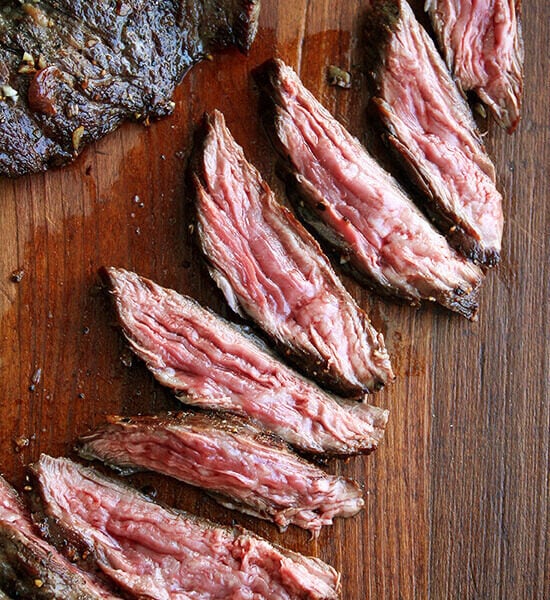Description
Note: Depending on where you get your skirt or flap steak, it might be cut into smaller pieces or it might be in one long piece. If it is in one long piece, cut it at the points where the thickness changes to ensure more even cooking.
If you like garlic, you can rub some over the steak, but know that it will burn when you are pan searing it. A little charring is fine; a lot is not recommended. If you use it, be sure to rub most of it off before searing.
Also, skirt steaks are thinner than flap steaks and as a result will cook faster. Flap steaks at their thickest are barely an inch thick.
The original sauce recipe calls for chopped parsley at the end, which you could do, but I don’t find it to be necessary.
Hanger steak gets its name because it hangs from the diaphragm of the steer. It is also known as “the butcher’s steak” because allegedly it was the piece the butcher took home for himself and his family. As noted above, there is only one hanger (which can be cut into two pieces) per steer, and few markets carry it. If you live in the Schenectady area, you can order one from Bella Terra Farm — all of their meat is delicious. I’ve had their sausage, their skirt and hanger steaks. Again, skirt and flap steaks are great alternatives to hanger and are easier to find. Healthy Living in Saratoga carries delicious grass-fed skirt steak from two local farms, Hardwick and Boyden.
Ingredients
- 1 Tbsp grapeseed oil
- 1 skirt or flap steak, about 1 pound total
- Salt and freshly ground pepper
- 2 Tbsp unsalted butter
- 4 medium shallots, thinly sliced
- 2 Tbsp red wine vinegar (I used white balsamic)
- 1/2 cup red wine
Instructions
- Remove the steaks from the fridge an hour (if time allows) before serving to ensure they are at room temperature before cooking. Season with salt and pepper on both sides. If your steaks are really long, cut the meat at the points where the thickness changes. This will leave you with several pieces each with a uniform thickness.
- Heat oil in a large heavy-bottomed skillet or sauté pan over high heat. Pat the steaks dry with a paper towel — this will help them brown nicely. When the pan is hot, place the steaks into the pan, and reduce heat slightly (medium high to high is about right). For pieces that are about an inch thick, cook for three minutes a side. For pieces that are half an inch thick, cook two minutes a side. For thinner pieces, try two minutes on one side and maybe one to two minutes on the other side. These times are for steaks that will be medium-rare in doneness. Adjust times if you prefer a more well-done cooked steak. Remove steaks from pan, and let rest for 10 minutes.
- Reduce the heat to medium, add a tablespoon of butter and the shallots. Season with salt and pepper and cook, stirring frequently, until the shallots are soft but not colored, about 3 to 5 minutes. Add the vinegar and cook until it evaporates, then add the wine. Bring the wine to a boil and let it reduce by about half. Remove pan from heat and stir in the remaining tablespoon of butter. Transfer steaks to a cutting board. Pour the juices from the plate the steaks were resting on into the shallot sauce. Stir to combine.
- Slice steaks against the grain. Serve with the warm shallot sauce over top.
